 Sigiswald Kuijken and La Petite Bande, Telemann Trumpet and Horn Concertos (Accent 24318), 2016.
Sigiswald Kuijken and La Petite Bande, Telemann Trumpet and Horn Concertos (Accent 24318), 2016.
Jean-François Madeuf; natural trumpet and natural horn, Pierre-Yves Madeuf; natural horn. Sigiswald Kuijken, Jin Kim, and Barbara Konrad, violins; Marleen Thiers and Barbara Konrad, viola; Ronan Kernoa, basse violon; Benjamin Alard, harpsichord. Recorded January 13-15, 2016.
Jean-François Madeuf has done as much as any brass player active today to promote a historically informed approach to a wide range of the early brass repertoire. This CD is the latest in those efforts and the outcome is exquisite. He chose a program that has been extensively performed by both modern and early brass performers. Madeuf has chosen to deliberately contrast his approach with that of a well-known recorded legacy of this music. The five works by Georg Philipp Telemann (1681–1767), are Suite in D for trumpet, 2 violins, viola & b.c. TWV 55:D7, Concerto in D for horn, violin, 2 violas, b.c. TWV 51;D8, Sonate for trumpet, 2 violins, viola & b.c. TWV 44:D1, Concert in D for 2 horns, 2 violins, viola & b.c. TWV 52: D1, and Concert in D for trumpet, 2 violins, & bc. TWV 51: D7. There are two bonus tracts of the Sonata in D TWV 44: D1, which is performed according to a written suggestion in the score, without the trumpet in the first and third movements.
There are recordings that have elevated certain works to an iconic status. This is true for several of the pieces on this CD that were first recorded decades ago by great soloists such as Maurice André and Hermann Baumann. Having first heard those recordings as a young person, a sort of indelible association is stamped in one’s musical consciousness. For this listener the Telemann concerto for trumpet and strings is strongly associated with a recording by Maurice Andre. It is precisely because of those strong associations that Jean- François Madeuf chose to record these particular works. The contrasts are glaring which is exactly what is intended. In many recordings of this repertoire on modern instruments, the trumpet and horn are decidedly placed as soloists not as integral chamber musicians aiming for a musical collaboration of equal importance. The instrumentation with La Petite Bande is one or two to a part, not a large orchestra. The small forces allow for that sense of equality to come through.
The Madeuf brothers both play with exquisite precision and musicality. Ornamentation and articulations adhere to commonly accepted 18th century performance practice norms. Pierre-Yves is playing on a copy by Graham Nicholson of a Leichnamschneider original as is Jean-François when he joins his brother on the Concerto in D for 2 horns, 2 violins, viola and b.c. For the other works employing trumpet, Jean-François is playing on an original natural trumpet by Johann Wilhelm Haas. Both Madeuf brothers “switch-hit”, playing both trumpet and horn. This supports the notion advanced by some brass scholars that horn players and trumpeters were one in the same. Specialization on one or the other instrument is thought to be a later development. Pierre-Yves does not employ hand-stopping which, again, is thought to be a performance technique developed after the time of Bach.
Another performance practice issue that Jean-François Madeuf has argued is the use of very large trumpet mouthpieces. The beautiful portrait of Valentine Snow playing a 1715 trumpet by John Harris (housed in Fenton House, London) graces the cover of this CD (see the interesting article by David Edwards where he conjectures that the trumpeter in the portrait is Valentine Snow (HBS Newsletter 5, 1993). The mouthpiece depicted in this painting is very large by any standard, thus bolstering Madeuf’s views on mouthpiece size.
If you are like this listener, someone who first heard these pieces as a young listener on modern instrument recordings, then this CD may present a challenge. It is a challenge that the Madeuf brothers, Sigiswalk Kuijken and La Petite Bande confidently cast. It is well advised to listen with open ears. This stunning recording will allow you to hear the music in a new (old) way, a way closer to the wonderful sound-world of Georg Philipp Telemann.
-- Jeffrey Nussbaum
[editor's note: at the time of publication (10/4/16) the Accent website was not up and running and so no link to purchase the CD was been included.]



